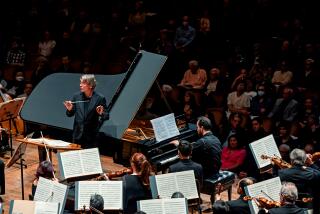Music Review : Beethoven Sonatas in an Industrial Park
- Share via
Far less fascinating than one might have wished, Eric Stumacher’s return engagement Sunday afternoon on the Chamber Music in Historic Sites series offered Beethoven sonatas and recent new music for computer-engaged piano. Despite the helpful presence of one of the living composers represented, it was easy to leave the event unamused.
As he had at his last Historic Sites appearance three years ago, pianist Stumacher offered a work by John Steinmetz; but this time he recycled the then-new Steinmetz piece he had played in 1987.
Sunday, heard from within a new conference room shaped like the inside of a football, neither piece intrigued the listener. Another unfamiliar contemporary work, Jon Deak’s 11-minute narrative, “Shiver Me Timbers,” using a text by Robert Louis Stevenson, also left the observer in the ho-hum mode.
Consequently, the most gripping element at this event, in a reconstituted industrial building in the southeast corner of Culver City, was the site itself.
This 6,000-foot-square complex, different parts of which are 60, 50 and 40 years old, has been rehabilitated near-totally under the supervision of architect Eric Owen Moss. Visiting different parts of the complex before the recital and during its intermission became the best part of the afternoon.
As played competently by Stumacher, Steinmetz’s Four Preludes for piano and computer are innocuous diatonic studies accompanied by plain sound effects.
His earlier, 21-minute “DATACOMP” seems to be a comedy routine with incidental music, and not one the listener wishes to hear a second time.
Stumacher’s first half also disappointed. His playing of Beethoven’s Sonata in E, Opus 90, and “Waldstein” Sonata, Opus 53, brought forward no fresh insights into familiar music. Indeed, inconsistencies of rhythm, as well as quirks in phrasing and dynamics, put both these acknowledged masterpieces well out of focus.
More to Read
The biggest entertainment stories
Get our big stories about Hollywood, film, television, music, arts, culture and more right in your inbox as soon as they publish.
You may occasionally receive promotional content from the Los Angeles Times.










